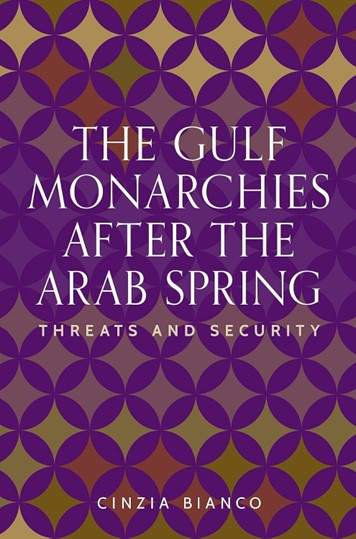Book Review - The Gulf Monarchies after the Arab Spring: Threats and Security

The Gulf Monarchies after the Arab Spring: Threats and Security by Cinzia Bianco. Manchester: Manchester University Press, 2024. 206 pp., £85 hardcover 978-1-5261-7084-2
The Gulf Cooperation Council (GCC) states, considered as islands of stability, were heavily affected by a combination of the game-changing events of the Arab Spring which substantially put into question their existing perceptions of security at home and in the region and led to the emergence of multi-dimensional and multi-layered security issues. Cinzia Bianco’s timely book challenges commonly held pre-Arab Spring narratives and monolithic understandings that saw the GCC monarchies as having shared security concerns – showing how and why their divergences have emerged (p.5). The book meticulously unpacks the threat perceptions and strategic calculus of each GCC monarchy, highlighting their distinct sociopolitical and socioeconomic vulnerabilities (p.20).
The conflictual foreign policies pursued by the six GCC countries in the post-Arab Spring era definitively challenge the argument that there was foreign policy coordination. Rejecting the generalizations and hyper-securitization that characterized the post-Arab Spring discourse, Bianco introduces new concepts and instruments to provide a nuanced understanding of security perceptions at the leadership level in each of the six GCC monarchies to comprehend their policies and positions (p.6).
 The book is systematically structured and divided into three parts: Part One focuses on Bahrain, Saudi Arabia, and the UAE; Part Two on Kuwait and Oman; and Part Three on Qatar, which stands out as a unique case. The book includes a combination of the quantitative (statistics and surveys) and qualitative research methods (interviews and discourse analysis) and the reliance on both theoretical knowledge and empirical data.
The book is systematically structured and divided into three parts: Part One focuses on Bahrain, Saudi Arabia, and the UAE; Part Two on Kuwait and Oman; and Part Three on Qatar, which stands out as a unique case. The book includes a combination of the quantitative (statistics and surveys) and qualitative research methods (interviews and discourse analysis) and the reliance on both theoretical knowledge and empirical data.
Building on Barry Buzan’s comprehensive concept of security, Bianco theorizes a differentiation between threats and risks (p.183). This risk/threat distinction has allowed for a more nuanced description of how a threat perceived by one state might be perceived just as a risk by another. As Bianco, notes, it is the decision-makers who ‘securitise’ risks into threats with their speech acts based on their security perceptions (p.44).
Additionally, Bianco categorizes threats by nature, type, and dimension to perform an effective threat analysis, going beyond the simple external-internal categorization, which does not fit the post-2011 reality of the GCC states (p.49). Bianco focuses on four dimensions of threat – political, military, economic, and social (p.40). Thus, in this book, Bianco’s contribution to the existing literature is three-fold: a) distinguishing between threats and risks, b) examining the interaction between structural and ontological vulnerabilities and leadership perception, and c) going beyond the traditional dichotomy of external threats (that affect the international interests of the country) and internal threats (having endogenous roots and affect the internal stability of the country), using the term ‘intermestic threats’ (pp.11-12). She explains ‘intermestic threats’ as having a mixed external and internal nature, such as those derived from exogenous motives but having domestic implications, or vice versa.
The hypothesis presented in the book is that ‘intermestic threats’ were highly prioritized by the GCC leaders, especially those originating abroad or abetted by foreign actors (p.53). These ‘intermestic threats’ are prominent in all six empirical chapters of the book, showing that every GCC monarchy is particularly concerned with them, yet in different ways (p.184). In the decade following the Arab Spring, the actors emerging as catalysts of the GCC countries’ security calculus were Iran - and its allied regional groups - and the diverse constellation of Islamist groups coalescing around the Muslim Brotherhood (p.185). Bianco focuses on two main threats that became catalysts of GCC states’ security perceptions: the ‘Islamist threat’, and the ‘Shi’a threat’. Six case chapters examine how these threats’ external and internal dimensions affect each GCC state’s security perception and strategic calculus.
Each leadership in the GCC viewed these two threats differently with regard to their own stability and security. For instance, Saudi Arabia and the UAE treated Islamism as an ‘intermestic threat’, exhibiting the most hyper-securitized approach. On the other hand, Qatar, a country perceiving virtually no domestic repercussions from the 2011 uprisings, showed no intention of adopting the hyper-securitized positions of the other GCC monarchies. While Kuwait and Oman, the neutral actors of the GCC, opted a hedging strategy between security and stability, and avoided being caught between pro-status quo and revisionist powers within the GCC. While discussing how the GCC states addressed the perceived ‘Islamist’ and ‘Shi’a’ threats, Bianco cites several incidents, offering readers a comprehensive process-tracing analysis. In doing so, she examines how each GCC state historically perceives Islamists, navigates its relations with its Shi’a populations, and broadly manages its relations with Iran.
This book’s findings confirm that GCC security is not a one-dimensional phenomenon but is instead a complex matrix of domestic and regional factors, each playing a distinctive role in formulating the definition, categorization, perception, and prioritization of threats (p.188) One key finding of the book is that GCC states increasingly view each other as potential sources of threats to stability, as evidenced by the 2017 Gulf crisis (p.187). Intra-GCC crises have shown that the sub-regional level of study is no longer sufficient to decode security perceptions in the GCC, and the domestic level is necessary (p.181). As Bianco notes, “the national chapters of the Arab Spring brought to the surface the different sociopolitical and socioeconomic vulnerabilities of the individual countries that, interpreted by the political culture and filtered by the governing systems, accelerated the polarisation of their security calculus, setting the monarchies on a collision course.” (p.181).
Acknowledging that Shi’a and Islamist threats are significant for GCC leaderships and they are ‘intermestic threats’ as they have both internal and external dimensions, it would be better if the book had touched upon the role of intra-ruling family rivalries, which could also act as a domestic threat with external dimensions. Additionally, while discussing the Shi’a threat, the book extensively covers Iran’s role but fails to address Turkey’s role in the Islamist threat related to the Muslim Brotherhood, as Turkey, alongside Qatar, was a notable regional actor ‘securitized’ by some GCC states in the post-2011 era.
Ultimately, this book is a significant contribution to the Gulf Studies literature, offering a rich framework of existing concepts and theories and detailed analysis based on the author’s field research. It is an essential read for scholars and policymakers interested in GCC policymaking as it unpacks the threat perceptions driving GCC states’ behavior, emphasizing their increasingly diverging domestic specificities (p.181). The study’s most valuable contribution is its nuanced understanding of the different facets of threat perceptions in the six GCC states individually through a meticulous conceptualization.
Sinem Cengiz is a Researcher at the Gulf Studies Center at Qatar University and a Non-Resident Fellow at Gulf International Forum in Washington D.C. She is a regular columnist for Arab News and a member of the Women in Foreign Policy Initiative. She is the author of Turkish-Saudi Relations: Cooperation and Competition in the Middle East and co-editor of The Making of Contemporary Kuwait: Identity, Politics, and Its Survival Strategy.


